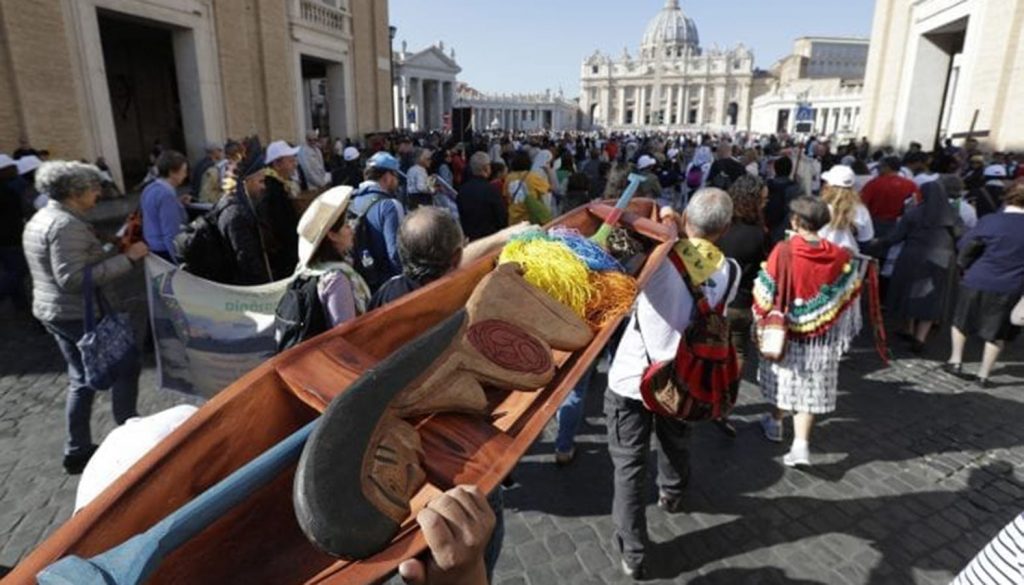Pope apologizes for theft of Pachamama, says she’ll be back on Sunday
Oct 25, 2019 • 3 Min Read

It’s become the symbolically defining storyline of the 2019 Synod of Bishops on the Amazon, and on Friday the drama surrounding the “Pachamama,” the indigenous statuettes of a naked pregnant woman that were stolen from a Rome church and tossed into the Tiber River, took yet another turn with an unexpected papal apology.
As he opened the afternoon session of the Oct. 6-27 synod Friday, Pope Francis addressed the theft of the statues on Oct. 21.
Saying he was speaking as the “Bishop of Rome,” meaning the head of the local church in the Eternal City, Francis requested “pardon” from anyone who was offended by the theft of the statues and their being thrown into the river.
According to a video of his remarks that made the rounds on social media, Francis said the statues had been displayed “without idolatry” in the Church of Santa Maria in Traspontina, located about halfway down the broad Via della Conciliazione that leads away from St. Peter’s Square.
Francis also added that Roman law enforcement officials have recovered the discarded statues and are holding them for the moment at a police station.
Friday’s apology caps what has been a month-long drama surrounding the statues, which first made an appearance during an Oct. 4 indigenous prayer service staged in the Vatican gardens in the presence of the pope.
Traditionalist and conservative critics immediately objected to what they saw as the idolatry of a pagan image unfolding on Vatican grounds, while some papal defenders insisted that the image was actually an indigenous depiction of the Visitation, when a pregnant Mary visited her relative Elizabeth, who was pregnant with John the Baptist.
Eventually Vatican spokesmen rejected both of those explanations, saying the images, which are only about a foot and a half tall, are simply expressions of indigenous reverence for life and devoid of any particular religious or spiritual significance.
“We know that some things in history can have many interpretations, and even in the Church you can find things that come from the past, but the statue simply represents life, period, while trying to see symbols of paganism is seeing evil where it’s not there,” said Italian layman Paolo Ruffini, the Vatican’s top communications official.
That did not quiet the controversy, however, as opinion on both sides of the debate sprouted both in social media and in Catholic news agencies.
In the meantime, after the images were carried during the synod’s opening procession Oct. 6 from St. Peter’s Basilica to the Vatican’s Synod Hall, they were displayed in the Traspontina church, where some bishops taking part in the summit have been conducting liturgies after the synod’s daily work is over.
On Tuesday, someone took public credit for the theft and discarding of the images: A 53-year-old Italian named Davide Fabbri, who goes by the pseudonym of “Padre Davide” and calls himself a “deacon exorcist” but, according to Italian media, is not actually ordained by the Catholic Church.
Fabbri released a video message on Youtube saying he was the one who took the statues, claiming they represented “satanism.”
Fabbri is a well-known personality in far-right political circles in Italy, who was once given a suspended jail sentence and a fine for a public defense of fascism in violation of Italian hate speech laws and for claiming, without confirmation, to be a distant relative of Benito Mussolini. Fabbri has also been filmed wearing clerical outfits during political rallies staged by Matteo Salvini, the leader of Italy’s far-right Lega party known for its hardline anti-immigrant stance and the country’s former Deputy Prime Minister.
In the meantime, Pope Francis told members of the Synod of Bishops that the statues will be back on Sunday, for the summit’s closing Mass.
No comments:
Post a Comment